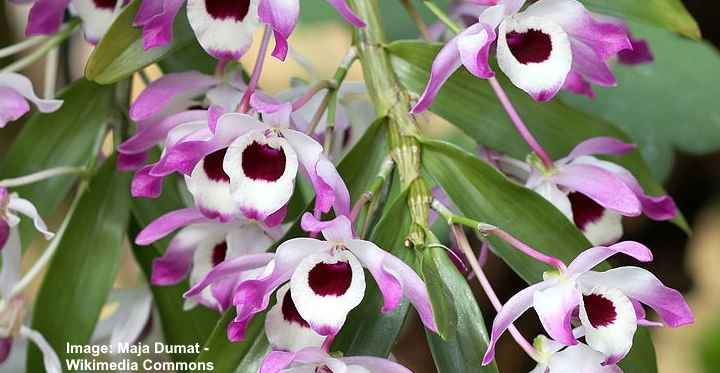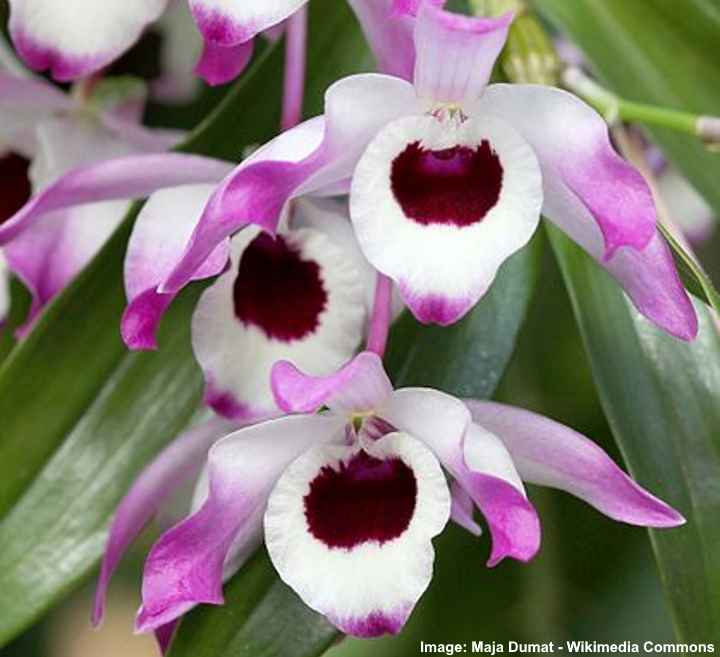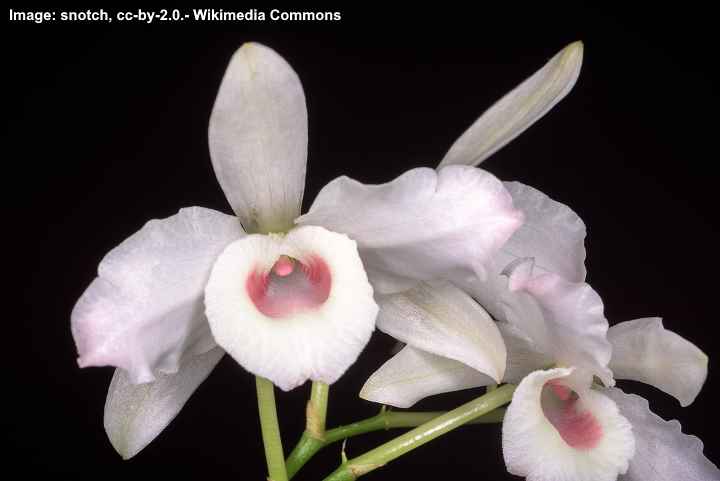Dendrobium Nobile Orchid – The Ultimate Care Guide

Dendrobium Nobile orchids are fragrant, colorful, and beautiful species of orchids. As a houseplant, dendrobiums are an easy-to-care-for plant. The orchids thrive in warm sunny locations where they provide stunning colors and wonderful scents. With the proper care, you too can grow a dendrobium orchid at home.
These flowering plants in the family Orchidaceae are native to many countries such as Southeast Asia, Indonesia, and Australia. There are over 1,800 species of dendrobium orchids.
The orchids are popular ornamental houseplants that transform a room with a spectacular display of flowers in winter and spring. When these orchids bloom, they produce delightful aromas when few other plants are blooming. The charming blooms are usually multicolored with various shades of white, pink, rose, lilac and purple.
Proper care of a nobile dendrobium involves having it in a bright location, giving it enough water, and keeping it at the right temperature. When you get the care right, the dendrobium orchids bloom between January and March.
In this article, you will learn how to care properly for dendrobium nobile orchids. You will get the best tips and tricks on pruning, feeding, and propagating these tropical houseplants.
How to Care for Dendrobium Orchids Indoors

Dendrobium nobile with pink and white flowers
Dendrobium nobile orchids need bright light to grow and can withstand direct sunlight. Average room temperatures of between 65 and 85°F (18 – 30°C) are ideal, and 50 – 70% humidity will help your orchid thrive. Orchid potting mix is the perfect growing medium and the plant needs feeding every two weeks.
Let’s look in more detail at the care requirements if you want to grow a dendrobium orchid indoors successfully.
Dendrobium Nobile Potting Mix

Dendrobium nobile orchid with white flowers
Nobile dendrobium orchids have two main requirements for a suitable potting medium. The mix should allow air to circulate and drain well. Suitable types of potting mix include coarse pine bark, coconut husk, or sphagnum moss. To care for your orchid, the potting mix should be consistently moist but never soggy.
All orchids, including dendrobiums, are epiphytic plants. It means that these types of flowering plants grow on the surface of other plants, such as trees. They draw moisture and nutrients from the air, rain, and debris that gather around the roots.
The perfect potting mix for orchids should try to mimic their native growing environment as much as possible.
The Best Place for Your Dendrobium Orchid
Care for your dendrobium nobile orchid by placing it in an area of your home that gets plenty of sunshine. Plenty of bright light ensures healthy growth, and your dendrobiums need a few hours of direct sunlight. An ideal place indoors is at a south-facing window where it gets filtered sun.
During mid-summer, you should be careful that too much sun doesn’t cause leaf burn. Signs of too much sun include yellow leaves or wrinkled leaves with brown tips. Moving your orchid away from a window that the sun shines through should help encourage healthy growth.
In temperate climates with warm summers, dendrobium orchids grow well outdoors. You can put them in a bright area on a patio, terrace, or balcony. Ideally, they need a place where they get partial shade.
When temperatures drop below 65°F (18°C), you should bring them indoors and place them in a bright, sunny room.
Dendrobium Nobile Orchid Temperature Requirements
Dendrobium orchids need specific temperatures to bloom every year. From spring until summer, average room temperatures are fine. Temperatures between 65 and 85°F (18 – 30°C) are ideal. During late fall and winter, cooler nighttime temperatures between 50 and 60°F (10 – 15°C) help stimulate bud growth and reblooming.
Many orchid experts recommend that dendrobiums get cool night temperatures in the fall and winter. Ideally, you need to make sure there is a 10°F to 15°F-degree difference between night and day temperatures. Once buds appear, you can keep them at least in 62°F (17°C).
During cloudy, cold winter days, you may need to use artificial heat to get the temperature difference just right.
If you care properly for your orchid by getting the temperature right, your plant should start flowering in January or February.
The Right Humidity for Dendrobium Nobile Orchids
Nobile dendrobium orchids require humidity of between 50 and 70%. You can hydrate the plant in several ways. Misting the orchid leaves and exposed roots, placing on a humidity tray, or grouping plants together are all effective ways to get the right humid conditions for healthy growth.
An essential piece of care advice for dendrobiums is to ensure proper air circulation. Damp, humid conditions can put your flowering orchid at risk of fungal disease and root rot. So, make sure your room is well-ventilated. In winter, when temperatures drop, you should carefully check humidity levels. Proper wintertime care could mean watering and misting less frequently.
As with caring for all types of houseplants, keep your orchids away from cold drafts.
How to Water Dendrobium Nobile Orchids
Dendrobium orchids require regular watering during the active growing summer months. How often should you water your dendrobium nobile orchid? Wait until the potting mix is almost dry. Always water in the morning and pour in enough water so that water drains from the bottom.
The frequency of when to water your orchid depends on several factors. Air temperature, humidity, type of pot, and time of year all affect moisture levels. A root-bound orchid will also retain more moisture than one with fewer roots.
During summer, you may need to water your orchid once a week or even more frequently. The hot weather, plenty of sunlight, and ventilation all cause the potting medium to dry out quicker.
If you grow your dendrobium nobile orchid outside in the summer, you should follow the same care routine. Wait until the top surface of the potting medium is nearly dry before thoroughly watering.
The sign to reduce watering is when the canes produce the last of the leaves in the fall. Only water your plant just enough to prevent the canes from dehydrating. This care tip helps to avoid any moisture-related fungal diseases.
The best tips for caring for your dendrobium are to only water when the potting mix is almost dry and never let the pot stand in water.
Feeding Requirements for Dendrobium Nobile Orchids
Fertilize your dendrobium orchid every one to two weeks during spring and summer. Use orchid fertilizer made up at half strength. You should stop feeding your orchid from September until February. Appropriate fertilizing is part of orchid care to encourage reblooming.
Getting fertilizing right is vital in your orchid care routine. Too much fertilizer can result in root burn and even cause your plant to die.
Over-fertilizing also encourages keikis to grow. Keikis are offshoots that sprout along the length of the cane. While you can use these to propagate a new orchid plant, you should prune them because they sap nutrients from the main plant.
The time to resume feeding your healthy dendrobium orchid is when you notice new growths at the base of the plant.
Repotting Nobile Dendrobium
Dendrobium orchids grow well when they become root bound, so only transfer them to a larger pot every two years. Signs that your nobile dendrobium needs repotting are poor drainage, roots overgrowing the pot, or when there are more roots than potting mix. Repot in a suitable container about 2” (5 cm) wider than its current one.
The optimal time to repot your orchid is in spring after the plant has ceased flowering. Repotting at this time encourages healthy growth and gives your plant room to grow.
To repot your dendrobium, remove the whole plant from its container. Remove all the bark, moss, or musk and rinse the roots. Then check for damaged or dead roots and prune them. After that, transfer the orchid into the new container, fill with orchid potting medium, and water thoroughly.
Repotting is also the perfect time to divide a large dendrobium. Ideally, you should have at least four healthy canes on each part. Cut through the rhizome with a sterilized sharp knife making sure not to damage healthy parts of the plant.
Avoid potting your new dendrobium in a large pot. These orchids grow better when the roots are somewhat restricted, even after repotting.
Dendrobium Nobile Propagation
Dendrobium orchid propagation is done in two ways. One is by starting orchids from cuttings, and the other is by dividing the rhizomes. Keikis growing on the mother stem can be used as cuttings. Wait until the keiki has developed at least four roots before carefully removing it from the stem.
Plant your new dendrobium orchid “cutting” in porous orchid potting medium, water it thoroughly, and put in a warm, bright place.
When propagating a dendrobium by the division method, try to keep as much of the root mass intact as possible. Divide the pseudobulbs, leaving between 4 and 6 canes on each one. Repot as outlined in the care instructions above.
Dendrobium Nobile Orchid Blooms
With the right care, your dendrobium should bloom every winter with stunning, fragrant flowers. The beautiful flowers can be white, purple, light pink, and lilac colors. The flowers are between 2 and 3” (5 – 7.5 cm) in size. You may get between 20 and 50 flowers or even more on a single cane!
When dendrobium orchids flower, they create a spectacular floral display. The long-lasting flowers give off a pleasant fragrance. With the beautiful colors and wonderful sweet aromas, dendrobiums are some of the most glamorous houseplants.
Dendrobiums flower between January and March.
When to Prune Dendrobium Orchids
After they have finished blooming, you can prune the orchids to ensure healthy growth. Pinch off the flower spikes that are close to the canes. However, you shouldn’t prune healthy-looking canes because they can still rebloom.
Check for any canes that look dried and shriveled as you can prune these.
Nobile Dendrobium Reblooming
With the proper care, a dendrobium nobile will produce flowers year on year. After blooming has ceased in March, cut off the flower spikes. Then care for your dendrobium orchid with regular watering, feeding, putting it in a bright place, and keeping the temperature warm.
The dendrobium’s active growth cycle is from April to August. When growth slows, and no new leaves appear, hold back with feeding and watering. To encourage reblooming, make sure there is at least a 10-degree difference in daytime and nighttime temperatures in fall and early winter.
The ideal temperatures to ensure reblooming are daytime temperatures between 65 and 70°F (18 – 21°C) and between 50 and 60°F (10 – 15°C) during the night. When buds start to develop, make sure that temperatures don’t drop below 54°F (12°C).
If you want to guarantee that your nobile dendrobium orchid blooms with a little care as possible, check out some new easy-to-care-for dendrobium cultivars.
Are Dendrobium Nobile Orchids Toxic?
There is no evidence to suggest that dendrobium nobile orchids are toxic for humans, cats, dots, or other household pets.
Dendrobium Nobile Orchids: Pests and Diseases
Orchids in the genus Dendrobium are hardy tropical plants that are resistant to many pests. If you look after your dendrobium orchid properly, you can grow a healthy plant that doesn’t succumb to diseases and pests.
What are the common pests that can affect dendrobium orchids? The most common parasite affecting dendrobium orchids is scale. Usually, wiping the leaves with rubbing alcohol is enough to remove the bugs. However, thrips, mealybugs, fungus, gnats, and mite can also affect your plant.
You can prevent most fungal diseases by making sure you water the plant correctly. Overwatering and humid conditions result in a soggy potting medium where diseases such as Pythium, Phytophthora, and botrytis can kill your orchid plant.
Signs of fungal or bacterial disease are usually black spots on flowers or leaves, wilting stems, or withered leaves. You can try to save your dying orchid plant by repotting it and cutting off any diseased roots. Make sure and follow the proper care instructions to water a dendrobium nobile properly.
Common Problems Affecting Care of Dendrobium Orchids
Although nobile dendrobiums are not difficult to care for, there are a few things that can affect their care. Here are some common issues that affect dendrobiums.
Why does a dendrobium orchid develop yellow leaves?
There are a few reasons why dendrobium nobile orchid leaves turn yellow.
These orchids are semi-deciduous, and they will lose some leaves as part of their normal growth cycle. Shedding old yellow leaves is nothing to worry about.
In some cases, yellowing leaves can be a sign of too much or too little water. If the potting medium is too soggy, you may be over-watering your plant. So, wait until the top layer of bark or moss is nearly dry before watering. If the yellow leaves feel dry and look shriveled, you may need to water more frequently.
If you are watering your plant correctly, yellow leaves may be a lack of nutrients. So, check that you are adding enough fertilizer during the active growing season.
My dendrobium orchid appears to be dying
Severe leaf drop could be a sign that your dendrobium nobile orchid is dying. The most common cause is watering issues. Always make sure that the potting medium is only ever slightly moist and is never overly damp or soggy.
You could try to repot your orchid and check for signs of soggy or decaying rhizomes. Repotting may be the only way to save a dying dendrobium nobile orchid.
Related articles:
